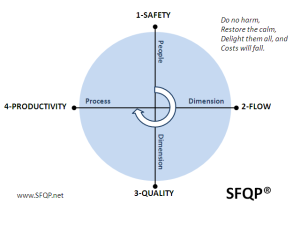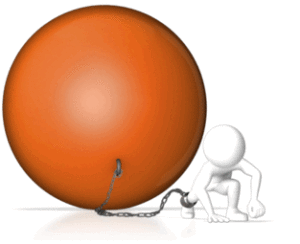It was the time for Bob and Leslie’s regular coaching session.  Bob was already on line when Leslie dialed in to the teleconference.
Bob was already on line when Leslie dialed in to the teleconference.
<Leslie> Hi Bob, sorry I am a bit late.
<Bob> No problem Leslie. What aspect of improvement science shall we explore today?
<Leslie> Well, I’ve been working through the Safety-Flow-Quality-Productivity cycle in my project and everything is going really well. The team are really starting to put the bits of the jigsaw together and can see how the synergy works.
<Bob> Excellent. And I assume they can see the sources of antagonism too.
<Leslie> Yes, indeed! I am now up to the point of considering productivity and I know it was introduced at the end of the Foundation course but only very briefly.
<Bob> Yes, productivity was described as a system metric. A ratio of a steam metric and a stage metric … what we get out of the streams divided by what we put into the stages. That is a very generic definition.
<Leslie> Yes, and that I think is my problem. It is too generic and I get it confused with concepts like efficiency. Are they the same thing?
<Bob> A very good question and the short answer is “No”, but we need to explore that in more depth. Many people confuse efficiency and productivity and I believe that is because we learn the meaning of words from the context that we see them used in. If others use the words imprecisely then it generates discussion, antagonism and confusion and we are left with the impression of that it is a ‘difficult’ subject. The reality is that it is not difficult when we use the words in a valid way.
<Leslie> OK. That reassures me a bit … so what is the definition of efficiency?
<Bob> Efficiency is measure of wasted resource – it is the ratio of the minimum cost of the resources required to complete one task divided by the actual cost of the resources used to complete one task.
<Leslie> Um. OK … so how does time come into that?
<Bob> Cost is a generic concept … it can refer to time, money and lots of other things. If we stick to time and money then we know that if we have to employ ‘people’ then time will cost money because people need money to buy essential stuff that the need for survival. Water, food, clothes, shelter and so on.
<Leslie> So, we could use efficiency in terms of resource-time required to complete a task?
<Bob> Yes. That is a very useful way of looking at it.
<Leslie> So, how is productivity different? Completed tasks out divided by the cash in to pay for resource time would be a productivity metric. It looks the same.
<Bob> Does it? The definition of efficiency is possible cost divided by actual cost. It is not the same as our definition of system productivity.
<Leslie> Ah yes, I see. So do others define productivity the same way?
<Bob> Let us try looking it up on Wikipedia …
<Leslie> OK … here we go …
“Productivity is an average measure of the efficiency of production. It can be expressed as the ratio of output to inputs used in the production process, i.e. output per unit of input”.
Now that is really confusing! It looks like efficiency and productivity are the same. Let me see what the Wikipedia definition of efficiency is …
“Efficiency is the (often measurable) ability to avoid wasting materials, energy, efforts, money, and time in doing something or in producing a desired result”.
But that is closer to your definition of efficiency – the actual cost is the minimum cost plus the cost of waste.
<Bob> Yes. I think you are starting to see where the confusion arises. And this is because there is a critical piece of the jigsaw missing.
<Leslie> Oh …. and what is that?
<Bob> Worth.
<Leslie> Eh?
<Bob> Efficiency has nothing to do with whether the output of the stream has any worth. I can produce a worthless product very efficiently. And what if we have the situation where the output of my process is actually harmful. The more efficiently I use my resources the more harm I will cause from a fixed amount of resource … and in that situation it is actually safer to have an inefficient process!
<Leslie> Wow! That really hits the nail on the head … and the implications are … um … profound. Efficiency is objective and relates only to flow … and between flow and productivity we have to cross the Safety-Quality line. Productivity also includes the subjective concept of worth or value. That all makes complete sense now. A productive system is a subjectively and objectively win-win-win design.
<Bob> Yup. Get the safety, flow and quality perspectives of the design in synergy and productivity will sky-rocket. It is called a Fit-4-Purpose design that creates a Value-4-Money product or service





